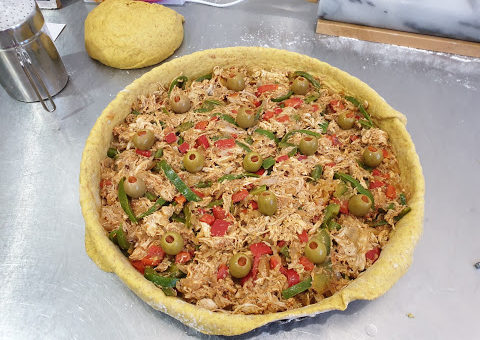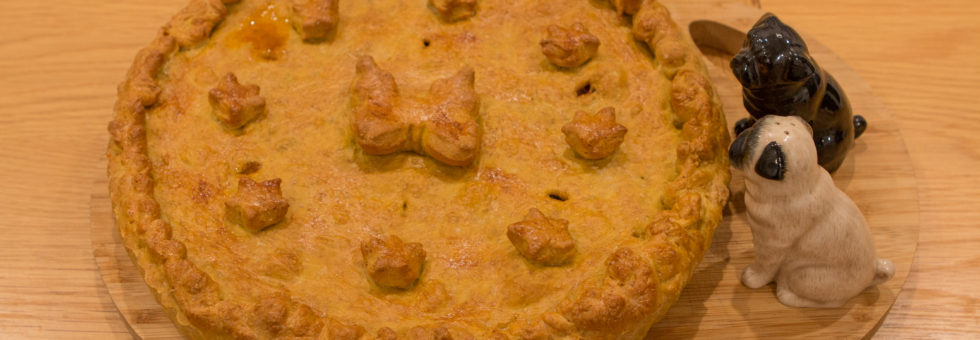Galician pie is a traditional dish renowned throughout Galicia and the whole of Spain. It is enjoyed by natives, tourists and particularly by pilgrims arriving in Santiago de Compostela at the end of the Camino de Santiago, or the Way of Saint James.
The pie can contain a variety of fillings including chicken, pork, tuna and others. For this recipe, the filling was made by boiling chicken with carrot, leek, celery and coriander, then making a sauce by frying onion, garlic, peppers with spices and condiments, topped with pimento stuffed olives. Some recipes are more tomato-based and others also include boiled egg. Unusually, the pastry happened to be made like a bread, and involved both kneading, proving and the use of strong white bread flour. It is flavoured with turmeric, paprika and wine vinegar. In true Spanish fashion, the recipe contains two different types of paprika: sweet and smoked. Unfortunately I had neither and could only source hot paprika, but it served me well.
Translation
Sofrito
Interestingly, my recipe divides the filling into two parts: the chicken filling and the “sofrito”. A “sofrito” is a mixture of ingredients, typically tomato, onion, and garlic, which are fried on a low heat until slightly golden and is used to form the basis of a stew, or in this case the sauce for the pie filling. I decided it would be more commonly referred to as the “sauce” in this context.
Masa
English can often be a more specific language than Spanish, with us having a dedicated word for certain terms, where the Spanish would use a more generic one. One such example is the word “masa”, which is very versatile in the Spanish culinary world and can be used to describe both cooked and uncooked versions of the following:
- Pastry
- Dough (bread, pizza, cookie, biscuit, pasta)
- Batter
- Paste (e.g. for making croquettes)
El Taller de Repostería offers a comprehensive overview of a masa (in Spanish). Since this is a pie recipe, I am inclined to say this is a pastry in this context. However, the “masa” contains yeast and needs to be left to prove, and then knocked back. That sounds remarkably like a bread dough to me! Definitely a confusing one.
According to the Collins dictionary, the definition of a dough is “a fairly firm mixture of flour, water and sometimes also fat and sugar. It can be cooked to make bread, pastry and biscuits.” I would say that here, before the “masa” is cooked it is a dough, after which it becomes a pastry. Although using the word “pastry” feels misleading as the dough is more one of a bread, for the purposes of this dish it is functioning as a pastry.
After leaving the pastry dough to prove, the recipe tells you to “le sacas el aire”, literal translation: remove the air from it. We have a specific term for this in English: ”to knock it back”, which is what I opted for.

Brunoise
The recipe instructed me to chop the onion and garlic “en brunoise”, a French term affectionately adopted by Spanish recipes, which I discovered is also a term used in English. Nevertheless it was new to me and I learnt that brunoise is a culinary knife cut in which the item is first sliced and then turned a quarter turn and diced again. Depending on the ingredient, additional cuts may be used, e.g. with onions you would also perform at least one horizontal slice before chopping vertically. This seems to be an overly complicated term for a layperson reading a recipe, and one which we wouldn’t generally use in this context, so I opted for “finely chop”. To learn more about how to brunoise an onion, see here. Once you try this highly effective way of finely chopping an onion you won’t look back!
Life of pie
Although the Spanish word “empanada” is in use in the UK, it has different connotations to what we are talking about here. It is typically associated with a small Spanish or Latin American pastry turnover filled with savoury ingredients. However, the Spanish word “empanada” is a more general term for a type of larger pie. Their pies are different to those found in the UK, which can come in a variety of pastry combinations and depths. The traditional Galician pie is large, shallow and in this case uses a bread-like pastry flavoured with paprika. The fillings don’t tend to deviate from those previously described. For these reasons I chose to translate the name of the dish as “pie”, rather than “empanada”.
Pastasotto
The recipe helpfully suggests what to do with the leftover chicken stock and recommends using it to make sauces, risottos or “pastasotto”. I had never come across this dish before and learnt that it is a pasta dish cooked by adding small amounts of hot stock and stirring over the hob, much like a risotto. I decided this wouldn’t mean much to an English speaking audience as it’s not a dish widely known, so in order to effectively localise the translation to a British audience, I choose a very British equivalent suggestion: gravy. This is a viable alternative as gravy is made with stock and features among our traditional food.
Overall impression
The pie was straight-forward to make and the filling was delicious, providing just the right amount of heat from the paprika. Although I’m not usually a fan of olives, their saltiness perfectly complemented the rest of the filling. However, the crust was a little disappointing and was more of a bread masquerading as a pastry. I’ve seen that some other recipes do use a shortcrust pastry, which is what I would choose for a future version. A soured cream shortcrust pastry would marry well with the heat from the paprika.
Stay tuned for a sweet French bake next week…



